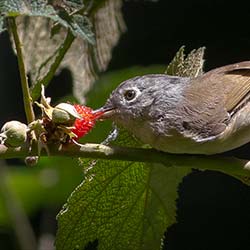
- Home
- Travel Packages
- Top Destination
-
Travel Attraction
By Category
Top Attraction

- Travel Agents
- Car Rentals
- Hotels

Ramna Bagan Wildlife Sanctuary
About Ramna Bagan Wildlife Sanctuary Ramna Bagan Wildlife Sanctuary is a picturesque sanctuary located in the Bardhaman district of West Bengal, India. Spread over an area of over 25 square kilometers, this sanctuary is a haven for nature lovers and wildlife enthusiasts alike. The sanctuary is home to a variety of flora and fauna, making it a popular destination for eco-tourism. Location and Geographical Overview The Ramna Bagan Wildlife Sanctuary is located in the Bardhaman district of West Bengal, approximately 70 kilometers from the city of Kolkata. Situated on the banks of the Ajay River, the sanctuary is known for its lush greenery and diverse wildlife. Opening and Closing Time The sanctuary is open to visitors from 6:00 AM to 5:00 PM every day of the week. Entry Fee There is a nominal entry fee of INR 50 for adults and INR 20 for children to visit the Ramna Bagan Wildlife Sanctuary. Species-Flora/Fauna Availability The sanctuary is home to a wide variety of flora and fauna. Visitors can spot animals like deer, monkeys, and various bird species during their visit. The lush greenery of the sanctuary is dominated by trees like Sal, Teak, and Mahogany. Activities Performed Visitors to the sanctuary can indulge in activities like bird watching, nature walks, and photography. The serene environment of the sanctuary makes it an ideal place to relax and unwind amidst nature. Jeep Safari Charges For those looking to explore the sanctuary in a more adventurous way, jeep safaris are available at an additional cost. The charges for a jeep safari start at INR 500 per person. Age Criterion and Entry Fee The entry fee for the Ramna Bagan Wildlife Sanctuary is INR 50 for male visitors, INR 30 for female visitors, and INR 20 for children. Senior Citizen Facilities Senior citizens above the age of 60 can avail a discounted entry fee of INR 30 to visit the sanctuary. Wheelchair facilities are also available for senior citizens who may require assistance. Best Time to Visit The best time to visit the Ramna Bagan Wildlife Sanctuary is during the winter months of November to February when the weather is pleasant and conducive for exploring the sanctuary. Nearby Places to Visit There are several attractions near the sanctuary that visitors can explore, including the historic temples of Bardhaman, the scenic Ajay River, and the bustling markets of the district. Vehicle Parking Facility Visitors can avail of the vehicle parking facility at the entrance of the sanctuary for a small fee. The parking area is secure and monitored by staff members for the safety of vehicles. Rules and Regulations Visitors to the Ramna Bagan Wildlife Sanctuary are required to maintain the sanctity of the sanctuary by not littering, feeding animals, or disturbing the natural habitat. Smoking and alcohol consumption are strictly prohibited within the premises. How to Reach and Other Related Information The sanctuary is easily accessible by road from major cities like Kolkata and Bardhaman. Visitors can take private or public transportation like buses or taxis to reach the sanctuary. It is recommended to plan your visit in advance and check for any updates on timings or entry fees before arriving at the sanctuary.
Explore More
Mahananda Weir Wildlife Sanctuary
About Mahananda Weir Wildlife Sanctuary The Mahananda Weir Wildlife Sanctuary is a beautiful sanctuary located in Siliguri, West Bengal, India. It is spread over an area of 159 sq km and is known for its rich biodiversity. The sanctuary was established in 1955 and is named after the Mahananda River that flows through it. The sanctuary is home to a wide variety of flora and fauna, making it a popular destination for nature lovers and wildlife enthusiasts. Location and Geographical Overview The Mahananda Weir Wildlife Sanctuary is located in the foothills of the Himalayas, near the town of Siliguri in West Bengal. It is situated at an altitude of 600-1000 meters above sea level and is surrounded by lush green forests and picturesque landscapes. The sanctuary is easily accessible by road and is a perfect getaway for those looking to escape the hustle and bustle of city life. Open and Closing Time The Mahananda Weir Wildlife Sanctuary is open to visitors from 6:00 am to 5:00 pm every day of the week, including weekends and holidays. It is recommended to visit the sanctuary during the early hours of the morning or late afternoon for the best wildlife spotting opportunities. Entry Fee The entry fee for the Mahananda Weir Wildlife Sanctuary is ₹50 for Indian nationals and ₹200 for foreign nationals. Children below the age of 5 years can enter free of cost. There is also a separate fee for vehicles entering the sanctuary. Species-Flora/Fauna Availability The Mahananda Weir Wildlife Sanctuary is home to a wide variety of flora and fauna. Some of the commonly found species include Indian bison, leopards, elephants, deer, various species of birds, butterflies, and reptiles. The sanctuary is also known for its rich plant diversity, with several species of trees, shrubs, and medicinal plants thriving in the area. Activities Performed Visitors to the Mahananda Weir Wildlife Sanctuary can enjoy a range of activities, including nature walks, bird watching, wildlife spotting, photography, and camping. The sanctuary also offers jeep safaris for those looking to explore the area and spot wildlife up close. Jeep Safari Charges The charges for a jeep safari at the Mahananda Weir Wildlife Sanctuary are ₹300 per person for Indian nationals and ₹800 per person for foreign nationals. The safari duration is approximately 1-2 hours, during which visitors are accompanied by experienced guides who provide information about the flora and fauna of the sanctuary. Age Criterion and Entry Fee For entry into the Mahananda Weir Wildlife Sanctuary, the age criterion is as follows: - Male: 5 years and above - Female: 5 years and above - Children: Below 5 years (entry free) The entry fee for Indian nationals is ₹50 and ₹200 for foreign nationals. Vehicle entry fees are charged separately. Senior Citizen Facilities The Mahananda Weir Wildlife Sanctuary offers special facilities for senior citizens, including designated seating areas, easy access to walking trails, and assistance from park staff if required. Senior citizens can also avail of discounts on entry fees and safari charges upon showing valid identification. Best Time to Visit The best time to visit the Mahananda Weir Wildlife Sanctuary is during the winter months from October to March when the weather is pleasant and the wildlife is more active. The monsoon season, from July to September, is also a good time to visit as the sanctuary is lush and green during this time. Nearby Places to Visit There are several nearby places to visit when in the vicinity of the Mahananda Weir Wildlife Sanctuary, including the Kali Mandir, Coronation Bridge, Sevoke Kali Mandir, and the picturesque town of Mirik. Visitors can also explore the tea gardens and enjoy a leisurely boat ride on the serene Mirik Lake. Vehicle Parking Facility The Mahananda Weir Wildlife Sanctuary has designated parking areas for visitors bringing their vehicles. There is ample parking space available, and park staff are present to assist visitors in finding a suitable parking spot. The parking fee is included in the vehicle entry fee. Rules and Regulations Visitors to the Mahananda Weir Wildlife Sanctuary are advised to follow certain rules and regulations to ensure the safety of the wildlife and maintain the sanctity of the sanctuary. Some of the key rules include no littering, no feeding or disturbing the animals, no loud noises, and no smoking within the sanctuary premises. How to Reach and Other Related Information The Mahananda Weir Wildlife Sanctuary is well connected by road and can be easily reached from Siliguri by private or public transport. The nearest airport is Bagdogra Airport, which is approximately 20 km away from the sanctuary. The nearest railway station is New Jalpaiguri Junction, which is about 25 km from the sanctuary. Accommodation options are available in Siliguri for those looking to stay overnight near the sanctuary.
Explore More
Sundarban National Park is a UNESCO World Heritage Site located in the South 24 Parganas district of West Bengal, near Kolkata. It is one of the largest and most unique mangrove ecosystems in the world and is home to the famous Royal Bengal Tiger. The park spans over 1,330 square kilometers and includes a vast network of tidal waterways, mudflats, and small islands covered with salt-tolerant mangrove forests. This area is not only rich in biodiversity but also serves as a protective barrier against coastal erosion and cyclones. It is a critical habitat for many endangered species including estuarine crocodiles, fishing cats, spotted deer, wild boars, and a variety of migratory birds. The name "Sundarban" is derived from the "Sundari" trees which dominate the region. How to Reach Sundarban National Park, South 24 Parganas, West Bengal, Kolkata Sundarban National Park is accessible from Kolkata, which is the nearest major city. Here are the common ways to reach the park: By Air: The nearest airport is Netaji Subhas Chandra Bose International Airport in Kolkata, which is about 120 km away. From the airport, visitors can hire a taxi or take public transport to reach the park. By Train: Canning is the nearest railway station to Sundarbans, located about 48 km from the park. Regular local trains run from Sealdah station in Kolkata to Canning. From Canning, one can take road transport to reach Godkhali, the entry point to the Sundarbans. By Road: Buses and private vehicles can take you from Kolkata to Godkhali via Canning. From Godkhali, you need to board a motorboat to enter the national park area. By Water: Sundarbans is best explored by boat. Several tour operators offer packages from Kolkata including boat rides, accommodation, and guided tours. Weather in Sundarban National Park The climate in Sundarbans is tropical and humid. Summers (March to June) are hot and humid, with temperatures ranging between 30°C and 42°C. The monsoon season (July to September) brings heavy rainfall and is not ideal for travel due to flooding and strong currents. The best time to visit Sundarbans is during the winter months (October to February), when the weather is cool and pleasant, making it easier to explore the forest and spot wildlife. Timing of Visit Sundarban National Park is generally open to tourists from 8:00 AM to 6:00 PM. Boat safaris usually start in the morning and last for several hours depending on the tour package. It is recommended to start early in the day to make the most of your visit. Why is Sundarban National Park Famous? Sundarbans is world-famous for being home to the elusive Royal Bengal Tiger, which is known for its ability to swim between the islands. It is also renowned for its dense mangrove forests, unique biodiversity, and ecological importance. The park is one of the few places where you can see tigers in their natural habitat, along with crocodiles, snakes, rare birds, and river dolphins. It is also significant for researchers and ecologists due to its role in coastal protection and carbon sequestration. Entry and Visit Details To visit Sundarban National Park, one must obtain permission from the Forest Department. Entry fees vary depending on the nationality of visitors, the number of people, and whether a guide is included. Indian Citizens: ₹60–₹100 per person Foreign Tourists: ₹200–₹500 per person Camera Charges: Additional fees apply Guides: Hiring an authorized guide is mandatory Boat Charges: Charges depend on the duration and type of boat used It's advisable to book through a government-approved tour operator or an ecotourism agency to ensure permits, safety, and guided information. History and Architecture The Sundarbans has a long and storied history that dates back thousands of years. The region has been referenced in ancient Indian texts and was a vital part of maritime trade routes. During British colonial rule, the area was surveyed and forest management practices were introduced. Although the region is not known for man-made architecture, the natural architecture of the mangroves is itself a marvel. The dense network of roots and waterways forms a living fortress against natural disasters. Watchtowers such as Sajnekhali, Dobanki, and Sudhanyakhali offer panoramic views of the forest and are key points of interest for visitors. Things to Do in Sundarban National Park Visitors can enjoy a variety of activities in Sundarbans: Boat Safari: The best way to explore the national park, offering chances to spot wildlife and experience the tranquil beauty of the mangroves. Bird Watching: Ideal during winter when migratory birds visit the park. Watch Towers: Visit towers like Sajnekhali and Sudhanyakhali for the best wildlife viewing experiences. Village Tours: Interact with local communities and learn about their lifestyle and folk culture. Photography: A paradise for nature and wildlife photographers. Facts and Tips about Sundarban National Park Sundarbans is the world’s largest tidal halophytic mangrove forest. It covers parts of India and Bangladesh. The park is a UNESCO World Heritage Site since 1987. Tigers in Sundarbans are known to be excellent swimmers. There are no jeep safaris—boat is the only way to explore the park. Travel Tips: Always travel with a registered tour operator for safety and permits. Wear light cotton clothes, carry mosquito repellent, and sunscreen. Photography is allowed, but drones may require special permissions. Mobile connectivity may be weak inside the park. Do not litter or feed animals; follow all forest department rules.
Explore More4D Darjeeling - Mirik Tour Package
4 Days/ 3 Night
Darjeeling - Mirik
Sikkim 5N - 6D Tour Package
6 Days/ 5 Night
Gangtok - Darjeeling - Pelling
Darjeeling - Pelling - Ravangla - Namchi 6 Days 5 Nights Tour
6 Days/ 5 Night
Ravangla - Darjeeling - Pelling - Namchi
3N Darjeeling - Gangtok Tour Package
4 Days/ 3 Night
Gangtok - Darjeeling